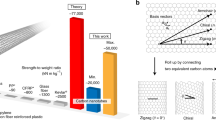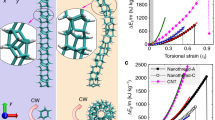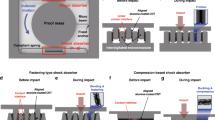Abstract
Structural components subject to cyclic stress can succumb to fatigue, causing them to fail at stress levels much lower than if they were under static mechanical loading1. However, despite extensive research into the mechanical properties of carbon nanotube structures2,3,4,5,6,7,8,9 for more than a decade, data on the fatigue behaviour of such devices have never been reported. We show that under repeated high compressive strains, long, vertically aligned multiwalled nanotubes exhibit viscoelastic behaviour similar to that observed in soft-tissue membranes10,11. Under compressive cyclic loading, the mechanical response of the nanotube arrays shows preconditioning, characteristic viscoelasticity-induced hysteresis, nonlinear elasticity and stress relaxation, and large deformations. Furthermore, no fatigue failure is observed at high strain amplitudes up to half a million cycles. This combination of soft-tissue-like behaviour and outstanding fatigue resistance suggests that properly engineered nanotube structures could mimic artificial tissues, and that their good electrical conductivity could lead to their use as compliant electrical contacts in a variety of applications.
This is a preview of subscription content, access via your institution
Access options
Subscribe to this journal
Receive 12 print issues and online access
$259.00 per year
only $21.58 per issue
Buy this article
- Purchase on Springer Link
- Instant access to full article PDF
Prices may be subject to local taxes which are calculated during checkout




Similar content being viewed by others
References
Dieter, G. E. Mechanical Metallurgy (McGraw-Hill, New York, 1986).
Treacy, M. M. J., Ebbesen, T. W. & Gibson, J. M. Exceptionally high Young's modulus observed for individual carbon nanotubes. Nature 381, 678–680 (1996).
Dresselhaus, M. S., Dresselhaus, G. & Eklund, P. C. Science of Fullerenes and Carbon Nanotubes (Academic, San Diego, 1996).
Yu, M. F. et al. Strength and breaking mechanism of multiwalled carbon nanotubes under tensile load. Science 287, 637–640 (2000).
Wei, C. Y., Cho, K. J. & Srivastava, D. Tensile strength of carbon nanotubes under realistic temperature and strain rate. Phys. Rev. B 67, 115407 (2003).
Yakobson, B. I., Campbell, M. P., Brabec, C. J. & Bernholc, J. High strain rate fracture, and c-chain unraveling in carbon nanotubes. Comput. Mater. Sci. 8, 341–348 (1997).
Cao, A., Dickrell, P. L., Sawyer, W. G., Ghasemi-Nejhad, M. N. & Ajayan, P. M. Super-compressible foamlike carbon nanotube films. Science 310, 1307–1310 (2005).
Falvo, M. R. et al. Bending and buckling of carbon nanotubes under large strain. Nature 389, 582–584 (1997).
Yakobson, B. I., Brabec, C. J. & Bernholc, J. Nanomechanics of carbon tubes: Instabilities beyond linear response. Phys. Rev. Lett. 76, 2511–2514 (1996).
Viidik, A. Functional properties of collagenous tissues. Int. Rev. Connect. Tissue Res. 6, 127–215 (1973).
Fung, Y. C. Biomechanics: Mechanical Properties of Living Tissue (Springer-Verlag, New York, 1993).
Zhang, X. et al. Rapid growth of well-aligned carbon nanotube arrays. Chem. Phys. Lett. 362, 285–290 (2002).
Kuzumaki, T. & Mitsuda, Y. Nanoscale mechanics of carbon nanotube evaluated by nanoprobe manipulation in transmission electron microscope. Jpn. J. Appl. Phys. 45, 364–368 (2006).
Suhr, J., Koratkar, N., Keblinski, P. & Ajayan, P. M. Viscoelasticity in carbon nanotube composites. Nature Mater. 4, 134–137 (2005).
Nieh, T. G., Higashi, K. & Wadsworth, J. Effect of cell morphology on the compressive properties of open-cell aluminum foams. Mater. Sci. Eng. A283, 105–110 (2000).
Fung, Y. C. Biorheology of soft tissues. Biorheology 10, 139–155 (1973).
Sanjeevi, R. A viscoelastic model for the mechanical properties of biological materials. J. Biomech. 15, 107–109 (1982).
Jozsa, L. & Kannus, P. A. Human Tendons—Anatomy, Physiology, and Pathology (Human Kinetics, Champaign, Illinois, 1997).
Hunter, L. W. & Lafontaine, S. in Solid-State Sensor and Actuator Workshop, 5th Technical Digest. 178–185 (IEEE, 1992).
Huxley, A. F. Reflections on Muscle (Princeton Univ. Press, Princeton, New Jersey, 1980).
Lee, J. K. & Marcus, M.A. The deflection–bandwidth product of poly(vinylidene fluoride) benders and related structures. Ferroelectrics 32, 93–101 (1981).
Lovinger, A. J. Ferroelectric polymers. Science 220, 1115–1121 (1983).
Baughman, R. H., Schacklette, L. W., Elsenbaumer, R. L., Plichta, E. J. & Becht, C. Microelectromechanical Actuators Based on Conducting Polymers (Molecular Electronics, Kluwer, The Netherlands, 1991).
Caldwell, D. G. Pseudomuscular actuator for use in dextrous manipulation. Med. Biol. Eng. Comput. 28, 595–600 (1990).
Acknowledgements
We thank S. J. Rock for help with sample preparation. P.M.A. acknowledges funding support from the Focus Center New York for Interconnects.
Author information
Authors and Affiliations
Contributions
All authors discussed the results and commented on the manuscript.
Corresponding authors
Ethics declarations
Competing interests
The authors declare no competing financial interests.
Rights and permissions
About this article
Cite this article
Suhr, J., Victor, P., Ci, L. et al. Fatigue resistance of aligned carbon nanotube arrays under cyclic compression. Nature Nanotech 2, 417–421 (2007). https://doi.org/10.1038/nnano.2007.186
Received:
Accepted:
Published:
Issue Date:
DOI: https://doi.org/10.1038/nnano.2007.186
This article is cited by
-
Giant nanomechanical energy storage capacity in twisted single-walled carbon nanotube ropes
Nature Nanotechnology (2024)
-
Accurate additive manufacturing of lightweight and elastic carbons using plastic precursors
Nature Communications (2024)
-
Mitigating Oblique Impacts by Unraveling of Buckled Carbon Nanotubes in Helmet Liners
Experimental Mechanics (2024)
-
Highly cross-linked carbon tube aerogels with enhanced elasticity and fatigue resistance
Nature Communications (2023)
-
High cycle fatigue behavior and thermal properties of PLA/PCL blends produced by fused deposition modeling
Journal of Polymer Research (2023)



